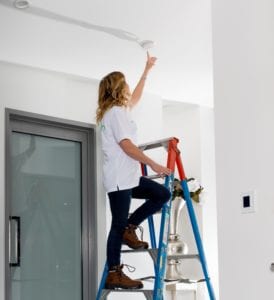This audio was created using Microsoft Azure Speech Services
Lightning storms, fires, and overloaded electrical grids often result in power outages. Such unanticipated blackouts can pose a serious threat to building occupants and property. According to the United States Fire Administration (USFA), from 2014 to 2016, an estimated 100,300 nonresidential building fires were reported each year which caused an average of 90 deaths; 1,350 injuries; and $2.4 billion in property losses per year (US only data).
As such, governments across the globe mandate safety regulations that require the installation of emergency lighting and smoke extraction systems in all public buildings and facilities. These systems are often placed along corridors, indicating a clear pathway for evacuation, at stairwells and at exit points. These safety systems, when properly functioning, save lives and minimize panic and chaos when facilities need to be quickly evacuated.
Whenever any new public facility (shop, store, factory, warehouse, etc.) is built, government-sanctioned inspectors will determine whether the new facility is safety compliant. If emergency lighting and smoke extraction systems are in order, then an official document certifies compliance and the facility is authorized to open to the public.
Building owners are responsible for purchasing, installing and maintaining these systems, and the expense is funded as part of the owner’s overall safety compliance budget.
How to make the right investment decision
Those responsible for selecting such systems should consider the following best practices:
Invest in solutions that comply with regulations
Government standards dictate parameters like the number of lights required per square meter of building, and the type of lights to be used. Size, wattage, heat emissions, life expectancy, uniformity of brightness, and compatibility with integrated circuits are all key specifications. End users should select vendors and installers that have access to system components that are pre-certified by the local authorities. This will save time and money and provide a safer environment for building occupants.
Don’t focus only on cost, but also on benefit
No one is happy when the government is forcing them to bear an additional expense when building a new facility. However, investment in a quality emergency lighting and smoke extraction system will lower insurance premiums, and, should the unexpected occur, will lower the risk of lawsuits targeting the building owner. Beyond cost avoidance, peace of mind and human safety are powerful benefits.
Technologies matter
In many cases the critical element within these systems is the transfer switch that senses the absence of current and the inverter that begins changing direct current from the battery to usable alternating current for the lights. Modern systems are often wired into an uninterruptible power supply (UPS) that contains an electronic transfer, transformer and inverter. These hardwired systems recharge the battery under normal conditions and transfer to battery power when the standard building power and/or lighting system fails.
Proper maintenance and testing are critical
All too often, once this equipment is installed it is soon forgotten. However, emergency lights and battery run times need to be checked and tested on a regular basis. Building owners are required to assure that the system is operational 24/7. In countries like France, tests are required once a month (a simple test to see if the lights switch on). Battery checks can range from once every six months to once a year. The owner has to assure enough working battery capacity to support a one-hour run time of the emergency lighting system. If it’s proven that the owner has not acted properly in the testing and maintenance of the system, the owner is liable and subject to fines and lawsuits (in the case of a failure during an emergency). The government, at any time, can request a record of system testing results.
Addressing facility safety
When working with a vendor, choose one that provides configuration tools with built-in local regulatory compliance parameters that allow partners to easily configure, specify and support certified emergency lighting and smoke extraction systems. Also, learn more about various industrial power protection solutions and how best to keep systems running.



Conversation
Isabella Erin
6 years ago
Extraordinary post, and awesome site. Much obliged for the data!